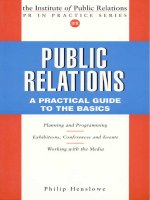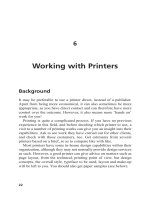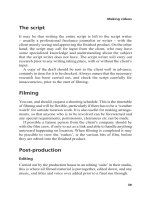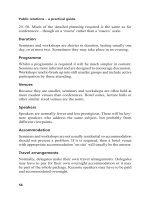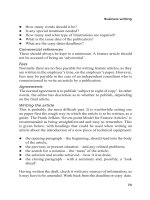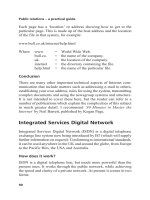A practical guide to job analysis prien goodtein
Bạn đang xem bản rút gọn của tài liệu. Xem và tải ngay bản đầy đủ của tài liệu tại đây (1.62 MB, 290 trang )
Essential resources for training and HR professionals
PRAISE FOR
Essential resources for training and HR professionals
A Practical Guide to Job Analysis
Rotman School of Management, University of Toronto
“Despite its essential quality, job analysis has been the neglected stepchild of the HR
world. This book changes all of that by providing the rationale, the tools, and the context for conceptualizing and implementing the best of job analysis practice.”
[ ROGER A. MYERS PH.D. ] ABPP, Richard March Hoe Professor (emeritus),
Teachers College, Columbia University
talent officer, Balfour Beatty Construction
ERICH P. PRIEN, Ph.D., is an industrial/organizational psychologist specializing
in the development, standardization, and application of psychological tests. He is the
founder and president of Performance Management Press.
LEONARD D. GOODSTEIN, Ph.D., is a consulting psychologist specializing
personality assessment. He is a principal with Professional Assessment Service and
Solutions.
JEANETTE GOODSTEIN, Ph.D., is an organizational consultant and writer
specializing in working with governmental and non-profit organizations. She is the coauthor of the award-winning Who’s Driving Your Bus and Applied Strategic Planning:
The Consultant’s Tool Kit.
LOUIS G. GAMBLE, JR., Ed. D., is a consultant and entrepreneur specializing in
the application of information technology to organizational change. He is a principal
with Inclusive Marketing Consultants, LLC.
JOB A N A LY S I S
“Prien, Goodstein, Goodstein, and Gamble have produced a practical, experience-based
book describing a foundational HR activity. It has already become a part of my reference library.”
[ JEFFERY S. SCHIPPMANN, PH.D. ] senior vice president, human resources and chief
A PRACTICAL
G U I D E TO
“The wisdom and years of experience of these icons in the field of industrial-organizational psychology is readily apparent on every page. This is a book that everyone who
works in human resources needs to have on their desk.”
[ GARY L ATHAM, PH.D. ] secretary of state professor, Organizational Effectiveness,
PRACTICAL
GUIDE
to
J OB
A N A LY S I S
E R I C H P. P R I E N
PRIEN
GOODSTEIN
GOODSTEIN
GAMBLE
Discover more at
www.pfeiffer.com
A
LEONARD D. GOODSTEIN
JEANETTE GOODSTEIN
LOUIS G. GAMBLE, JR.
About This Book
Why is this book important?
A competent job analysis is the foundation of all other human resource
functions. If we do not understand the nature of the job to be done, we
cannot select appropriate candidates for that job, assess their worth in the
job market, develop appropriate training and development programs, mentor
them, or adequately carry out any of the multitudinous HR functions. It all
must begin with a proper job analysis, a task for which this book provides a
comprehensive guide.
What can you expect from this book?
This book provides the reader with a context for understanding the importance
of doing a proper job analysis together with a step-by-step guide to conducting
such an analysis. One unique element of this guide is a series of eight templates
that provide the basis for conducting job analyses for eight different levels
of job families, from the entry-level to the senior manager/executive. HR
professionals or line managers can readily use these templates with confidence
that they have the necessary tools as well as the understanding of the context
of this process.
How is this book organized?
Beginning with two chapters on the context and importance of doing a competent job analysis, the book provides guides to specifying the work activities of
tasks that make up the job, identifying the competencies necessary to successfully perform that job, spelling out the unique characteristics of the workplace
in which the job will be performed, and finally, specifying the performance level
at which this job needs to be executed. The templates or instruments necessary
to complete each of the elements of a thorough job analysis are provided in
an appendix and on a website (www.pfeiffer.com/go/LeonardGoodstein). This
provides a convenient way that they easily can be customized for use in doing
a job analysis.
Our readers are invited to view and download the templates
and instruments from the appendices of this book. The
materials can be customized for use in doing a job analysis.
The materials are available FREE with the purchase of this
book at www.pfeiffer.com/go/LeonardGoodstein.
A Practical
Guide to
Job Analysis
Erich P. Prien,
Leonard D. Goodstein,
Jeanette Goodstein,
and Louis G. Gamble, Jr.
Copyright 2009 by John Wiley & Sons, Inc. All rights reserved.
Published by Pfeiffer
An Imprint of Wiley
989 Market Street, San Francisco, CA 94103-1741
www.pfeiffer.com
Except as specifically noted below, no part of this publication may be reproduced, stored in a retrieval system,
or transmitted in any form or by any means, electronic, mechanical, photocopying, recording, scanning, or
otherwise, except as permitted under Section 107 or 108 of the 1976 United States Copyright Act, without
either the prior written permission of the publisher, or authorization through payment of the appropriate
per-copy fee to the Copyright Clearance Center, Inc., 222 Rosewood Drive, Danvers, MA 01923,
978-750-8400, fax 978-646-8600, or on the Web at www.copyright.com. Requests to the publisher for
permission should be addressed to the Permissions Department, John Wiley & Sons, Inc., 111 River Street,
Hoboken, NJ 07030, 201-748-6011, fax 201-748-6008, or online at www.wiley.com/go/permissions.
Limit of Liability/Disclaimer of Warranty: While the publisher and author have used their best efforts in
preparing this book, they make no representations or warranties with respect to the accuracy or completeness
of the contents of this book and specifically disclaim any implied warranties of merchantability or fitness for a
particular purpose. No warranty may be created or extended by sales representatives or written sales materials.
The advice and strategies contained herein may not be suitable for your situation. You should consult with
a professional where appropriate. Neither the publisher nor author shall be liable for any loss of profit or any
other commercial damages, including but not limited to special, incidental, consequential, or other damages.
Readers should be aware that Internet websites offered as citations and/or sources for
further information may have changed or disappeared between the time this was written and when it is read.
Certain pages from this book and all the materials on the accompanying website are designed for use in a group
setting and may be customized and reproduced for educational/training purposes. The reproducible pages are
designated by the appearance of the following copyright notice at the foot of each page:
A Practical Guide to Job Analysis. Copyright 2009 by John Wiley & Sons, Inc. Reproduced by
permission of Pfeiffer, an Imprint of Wiley. www.pfeiffer.com
This notice may not be changed or deleted and it must appear on all reproductions as printed.
This free permission is restricted to limited customization of the website materials for your organization and
the paper reproduction of the materials for educational/training events. It does not allow for systematic or
large-scale reproduction, distribution (more than 100 copies per page, per year), transmission, electronic
reproduction or inclusion in any publications offered for sale or used for commercial purposes—none of which
may be done without prior written permission of the Publisher.
For additional copies/bulk purchases of this book in the U.S. please contact 800-274-4434.
Pfeiffer books and products are available through most bookstores. To contact Pfeiffer directly call our
Customer Care Department within the U.S. at 800-274-4434, outside the U.S. at 317-572-3985, fax
317-572-4002, or visit www.pfeiffer.com.
Pfeiffer also publishes its books in a variety of electronic formats. Some content that appears in print may not
be available in electronic books.
Library of Congress Cataloging-in-Publication Data
A practical guide to job analysis / Erich P. Prien ... [et al.].
p. cm.
Includes bibliographical references and index.
ISBN 978-0-470-43444-4 (cloth)
1. Job analysis. I. Prien, Erich P.,
HF5549.5.J6P73 2009
658.3’06 -dc22
2008051523
Acquiring Editor: Matthew Davis
Editorial Assistant: Lindsay Morton
Director of Development: Kathleen Dolan Davies
Manufacturing Supervisor: Becky Morgan
Production Editor: Dawn Kilgore
Editor: Rebecca Taff
Printed in the United States of America
Printing
10 9 8 7 6 5 4 3 2 1
Contents
Preface
xi
1.
1
An Introduction to Job Analysis
Why Do We Analyze Jobs?
The Hiring Process
The Human Capital Life Cycle
Job Analysis
Recruitment
Screening
Final Selection
Job Orientation
Training and Development
2.
What Is a Job Analysis?
11
Defining Job Analysis
Applications of Job Analyses
Recruitment
Candidate Selection
Employee Training and Development
Performance Management
Organizational Management and Planning
Litigation Protection
Elements of a Job Analysis
Work Activity (WA)
Knowledge, Skills, and Ability (KSA)
Levels of Job Performance
Workplace Characteristics
vii
viii CONTENTS
3.
How to Conduct a Job Analysis
27
Methods of Job Analysis
Self-Reports
Direct Observations
Interviews
Document Reviews
Questionnaires and Surveys
Caveats and Cautions
Changes Over Time
Low Accuracy
Lack of Stability
4.
The Job Analysis Templates
39
The Development of the Templates
Eight Templates for Job Analysis
Entry-Level Job Analysis Template (Appendix B)
Production Operations Job Analysis Template
(Appendix C)
Clerical Job Analysis Template (Appendix D)
Sales and Sales Management Job Analysis Template
(Appendix E)
Clerical/Administrative Services Job Analysis
Template (Appendix F)
Professional Administrative Job Analysis Template
(Appendix G)
Supervisory/First-Line Manager Job Analysis Template
(Appendix H)
Senior Management/Executive Job Analysis Template
(Appendix I)
Using the Templates
Completing the Summary Forms
Summary of Work Activity Importance Ratings
5.
The Workplace Characteristics Profile
Organizational Culture and Climate
Organizational Culture
Organizational Climate
53
CONTENTS
ix
The Workplace Characteristics Profile
Developing the WCP
Administering the WCP
Interpreting the WCP
6.
Establishing Job Performance Levels
63
Competencies and Jobs
The Uses of Job Performance Data
Recruitment
Creating Career Ladders
Evaluating Organizational Performance
Improving Organizational Performance
Methods for Measuring Job Performance
Objective Measures
Subjective Measures
Problems with Performance Ratings
Behaviorally Anchored Rating Scales (BARS)
How to Implement the BARS Method
A Recommended Shortcut
Applying the BARS Method
BARS and the Hierarchy of Jobs
Concerns About BARS
A Summary of the Job Analysis Process
References
85
Appendices∗
Appendix A: Sample Job Description
89
Appendix B: Entry-Level Job Analysis Templates
93
Appendix C: Production Operations Job Analysis
Templates
105
Appendix D: Clerical Job Analysis Templates
121
∗ All
Appendices are available for free download at
www.pfeiffer.com/go/LeonardGoodstein
x
CONTENTS
Appendix E: Sales and Sales management Job Analysis
Templates
135
Appendix F: Clerical/Administrative Services Job
Analysis Templates
151
Appendix G: Professional Administrative Job Analysis
Templates
169
Appendix H: Supervisor/First-Line Manager Job
Analysis Template
183
Appendix I: Senior Management/Executive Job
Analysis Templates
195
Appendix J: Summary of Importance of Work
Activities and Competencies
215
Appendix K: Workplace Characteristics Profile
249
Index
259
About the Authors
265
Preface
This workbook was written with three audiences in mind. The first
audience is the relatively new human resource (HR) professional
who needs to develop an understanding of the procedures and
methodology of job analysis in order to conduct such analyses
and then use the data from such analyses in their daily work.
The second audience is the experienced HR professional who
is trained and experienced in job analysis but who can use
specialized information about specific methods and approaches
for conducting job analyses, applying the results of such analyses,
and training and supervising more junior members of the HR
staff. A third audience is line managers who are interested in
understanding how competent job analyses can improve the
quality of the workforce and positively impact the bottom line.
The organization of this workbook follows the sequence in
which job analyses are conducted. The introductory chapter
places job analyses in the context of the process of the management of the organization’s most important asset—its human
capital. In the second chapter we discuss in some depth what is
involved in job analyses, including some caveats and cautions to
observe. Chapter Three provides a detailed description of how
to perform a job analysis. The next chapter provides information
on how to use the eight generic job analyses that are, to our
knowledge, unique contributions to the field. Each of these eight
generic job analyses then follows in a separate section, arranged in
order of increasing complexity of the job from entry-level jobs to
managerial positions. But work is always done in an organization,
xi
xii PREFACE
and the nature of that organization—its unique culture, strategy,
and structure—provides a context within which work is performed. No job analysis is complete without understanding the
characteristics of that workplace. The next chapter provides an
overview for understanding those characteristics and introduced
our Workplace Characteristics Profile (WCP), a newly revised
instrument for identifying the specific characteristics of a workplace that directly impact job performance. Our final chapter
deals with how the various levels of job performance can and
should be established. Thus we provide a comprehensive manual
for performing a job analysis.
Our focus is always on identifying and specifying the particular
tasks involved in effectively performing an identified job and the
necessary competencies required to do that job. Such a focus is
required to produce narrative job descriptions that can be used
successfully in recruiting, screening, selecting, and integrating
new employees into the workforce.
Although job analyses have been conducted on a systematic
basis in business and industry for many decades, for the most part
they have not led to producing job descriptions that effectively
communicate to others the competencies required to fill those
jobs successfully. It seems to us that many of these earlier job
descriptions were not written with sufficient attention to how
the information included was to be used. All too often, the focus
was on describing the tasks involved in the job, rather than on
the competencies necessary to carry out the tasks. This focus
left the end-user of the job description having to interpret the
competencies required for success from the narrative description.
The approach of this workbook is to obviate the need for such
interpretation. The model of job analysis presented here produces
both a clear statement of the work activities involved in the job
and the knowledge, skills, and abilities required for successful
performance of that job.
In conventional job analyses the individual(s) responsible for
performing the analysis must begin with an examination of the
PREFACE
xiii
tasks involved, and then determine the knowledge, skills, and
abilities necessary to perform those tasks; this analysis leads to a
job description that typically will combine similar tasks and then
separately identify the necessary competencies to perform each
set of tasks. This resultant job description serves as a template for
this specific job and others in that job family.
In order to circumvent this time- and labor-intensive process,
we have developed eight standardized questionnaires that ask
respondents first to rate the relative importance of each of a series
of work activities involved in a particular job family provided
in a list and, second, to rate the importance of a separate set of
competencies known to be involved in the successful completion
of those work activities. Compiling both these ratings of the
importance of various work activities and of the associated
competencies produces a job description based on quantitative
ratings that identify the required competencies.
Considerable prior work in developing standardized job analysis questionnaires does exist, but all of these efforts have focused
on producing a single set of work activities and competencies
(e.g., Fleishman, 1992). While there is merit in having a single
instrument that covers the entire range of jobs, we firmly believe
that such a single-minded approach cannot do justice to the
enormous range of jobs and competencies necessary in today’s
increasingly complex workplace. Chapter Four addresses these
issues in greater depth.
Any work of this scope involves the efforts of several others
besides the authors. We extend our sincere appreciation to
Dr. Kristin Prien for her technical assistance and, even more
importantly, her support and affection. Rebecca Taff provided
her usual editorial expertise to producing a final product, for
which we are exceedingly grateful.
1
AN INTRODUCTION TO JOB
ANALYSIS
Identifying the right person to fill a job vacancy has always
been difficult. Our aging, culturally diverse, and heterogeneous
workforce has increased that difficulty, and our globally competitive economy makes searching for competent workers an even
more formidable task. The rise of the Internet and the virtual
avalanche of resumes employers receive in response to each job
posting make the task of finding suitable candidates yet more
laborious.
Still, hiring the wrong people poses serious risks to all
businesses—from the smallest to the large, multinational corporation. Indeed, the costs of a hiring mistake are estimated to
be from one-half to ten times an individual’s yearly salary. The
expense of hiring mistakes must be controlled by using a systematic and consistent approach to identifying and hiring competent
and suitable people.
Hiring a competent and suitable individual to fill a position
is a true win-win proposition—a win for both the new employee
and the employer. Recruiting competent people for positions in
which they can succeed, feel good about what they are doing, and
experience the positive regard of their co-workers is highly reinforcing to everybody. New employees should experience a boost
in their sense of self-worth and self-esteem. They should begin
to feel secure and bring greater focus and energy to their work,
as job satisfaction increases. This growing sense of achievement
and capability, in turn, leads to greater increases in motivation,
to further achievement, and to a greater sense of competence.
1
2 A PRACTICAL GUIDE TO JOB ANALYSIS
Why Do We Analyze Jobs?
Completing a competent job analysis is ordinarily necessary in
order to write the job description, the formal statement of the
responsibilities involved, and the qualities necessary for success
on this specific job. Without such a job analysis, it is difficult, if
not impossible, to prepare a useful job description—and without
a job description it would be impossible to fill any job vacancy
successfully. A sample job description is included as Appendix A.
But job descriptions have a bad reputation in most organizations. Both employees and managers regard writing job
descriptions as a waste of time—until they need to use the
information from that job description. Many feel that job descriptions are too confining, that they limit people to a specific set
of tasks, and that they limit the behavior of job incumbents.
Consequently, writing job analyses is one part of human capital
management that everyone loves to hate, arguably even more
than performance reviews. People give various reasons for not
wanting to do (or even be involved in preparing) job descriptions:
• ‘‘It’s too much work, and I have more important things to
do.’’
• ‘‘It’s a waste of time; my people know what their jobs are.’’
• ‘‘Our jobs change too fast to write descriptions.’’
• ‘‘A job description is too confining. I want my people to
be flexible.’’
However, the information obtained from job analyses and
which leads to the job description is essential for virtually all
of the other human resources (HR) functions. The manager
who does not have time to work on job descriptions today
certainly doesn’t have time to defend against an EEO suit later.
Perhaps the current employees really do know what their jobs
are, but what happens when a key employee suddenly leaves,
and the information necessary for recruiting a replacement is
AN INTRODUCTION TO JOB ANALYSIS 3
not there? And if jobs are changing rapidly, knowing what skills
are needed to perform these jobs is even more essential, since
training people in the newly necessary skills will be a constant
requirement. Finally, while flexibility is good in the abstract,
organizations require a functional level of responsibility and
accountability, which requires job descriptions, which in turn
require competent job analyses. Thus, the job description should
include information about the duties the employee performs,
the knowledge, skills, and abilities, that is, the competencies,
necessary to perform those tasks, and any other job-related
information. Nowhere is this more important than in the hiring
process.
The Hiring Process
For the employer, hiring such people is equally important.
First, it saves money by raising productivity, lowering personnel
turnover, and reducing supervisory problems. Further, personnel
conflicts and problems decline sharply, as does the turnover of
new hires, all of which result in considerable savings in additional hiring costs and downtime. Proper selection processes
significantly reduce the risk of litigation for negligent or discriminatory hiring practices. An organization succeeds when its hiring
process places people in jobs that allow them to utilize their
abilities, capabilities, and skills. Finally, from a societal point of
view, good selection also provides genuine equal opportunity to
all people and helps our economy grow by increasing productivity
and reducing job dissatisfaction.
Despite the many benefits of hiring the right candidate to fill
a job vacancy, doing so is rarely easy for most organizations. In our
experience, one of the most important reasons for this difficulty
is that all too many supervisors and managers do not have a clear
understanding of the competencies necessary for success in that
job and how to assess those competencies. If you do not know
what you are looking for, it is difficult to find it!
4 A PRACTICAL GUIDE TO JOB ANALYSIS
Prior to an in-depth analysis of job analysis, it is important
to place job analysis in a proper context, one that illuminates
its importance in the management of an organization’s most
important asset, its human capital.
The Human Capital Life Cycle
We believe that the ideal human capital life cycle is best understood as involving six more or less discrete steps. All too often
employers do not differentiate these steps clearly and thus do
not follow them, leading to poor-quality outcomes. The six steps
approach employee recruitment, selection, and hiring as the initial aspects of an employee life cycle, one that is concerned with
employees throughout their employment careers. The six steps
are
• Job analysis
• Recruitment
• Screening
• Final selection
• Job orientation
• Training and development
Additional phases of human capital management appear
later in work life as employees move through a career and into
retirement, but we will concern ourselves only with these initial
six steps, ones that build on the job analysis and universally
affect virtually all employees and most jobs. Beginning with job
analysis, we will review each of these steps briefly.
Job Analysis
It is not possible to overestimate the importance of a competent
job analysis in the human capital process. It is the step on which
AN INTRODUCTION TO JOB ANALYSIS 5
the entire employee life cycle hinges and thus should be regarded
as one of the most important professional responsibilities of both
the human resource staff who must conduct thorough job analyses
and of their managers who must initiate and oversee the process.
Simply stated, the purpose of a job analysis is to provide an
in-depth understanding of the competencies required for success
in order to select appropriate candidates. A job competency is a
behavior, or set of behaviors, necessary to accomplish a specific
work task or achieve a specific goal. These competencies can
range from the most simple, such as filing, operating a punch
press, or answering callers politely and warmly, to the most
complex, such as neurosurgery or getting along with a difficult
supervisor.
The importance of using comprehensive job analyses in
selecting among candidates is strongly supported by empirical
research. This research (e.g., Campion, Palmer, & Campion,
1997; Campion, Pursell, & Brown, 1988;) clearly shows that,
when the hiring process was based on a careful job analysis,
the prediction of job success is greatly increased, and that it
is possible to identify correctly those candidates most likely to
succeed. This line of research also supports the conclusion that
much of the early research on the problems in predicting job
success was seriously flawed by one critical omission—the lack
of job analyses that identified the characteristics necessary for
success on that job. While the following chapters of this book are
concerned with the nuts and bolts of conducting a competent
job analysis, the remainder of this chapter will continue with the
importance of using job analyses throughout the employee life
cycle.
Recruitment
In job postings for recruiting candidates, the job analysis should
be used to clearly specify clearly the knowledge, skills, and
abilities (competencies) of successful candidates. Although this
6 A PRACTICAL GUIDE TO JOB ANALYSIS
will probably not reduce the flood of resumes that recruiters
currently experience with every job posting, it does serve two
important purposes: First, it provides a template for screening the
mass of resumes. Which of these resumes clearly indicates that
the sender possesses the requirements necessary for success? For
example, to what extent has the applicant tailored the resume
to fit the articulated set of requirements in the job posting?
How carefully has the resume been prepared? How often have
there been job changes? What is the nature of the self-described
accomplishments?
Second, an accurate and sufficiently detailed posting will serve
as a template that gives a measure of protection against charges
of discriminatory hiring. The degree to which the applicant does
not meet the specific requirements set forth in the job posting
is critical in any defense against discriminatory hiring practices,
providing that it can be shown that these requirements are
actually related to on-the-job success, a topic to which we return
later.
If the initial recruitment process includes some interviewing,
the recruiter needs to remember that this interview has two
purposes. One is to sell the job to attractive candidates, those
who appear to have the necessary set of requirements. The other
is to verify that the applicant does have the requirements. This
means that the recruiter must understand both the job and the
candidate well enough to probe for the validity of the information
contained in the resume. Deciding whether or not the recruiter
knows enough about the job to test the requirements should be
an important factor in selecting recruiters for specific jobs.
One of the dangers of conducting initial interviews of this
type is that the recruiter may view the purpose solely as selling
the candidate on the job. Organizations should be careful not to
reward recruiters for the number of candidates they promote
to the screening process. Rewarding recruiters for the number of
candidates who make it through the screening process to the final
selection stage is far wiser.
AN INTRODUCTION TO JOB ANALYSIS 7
Screening
Most hiring organizations do not make a clear distinction between
screening and selection, which means that the organization is
putting too much time, effort, and energy into examining too
many inappropriate candidates. By screening we mean the identification of those few applicants who appear most likely to possess
the requirements for advancement to the selection process. We
would argue that the optimal number of such candidates who
should be advanced to the final selection process is between three
and five.
Final Selection
This final selection among the best three to five candidates
will ordinarily involve a series of interviews with different key
supervisors and managers in the organization. All too often
the final selection process tends to be unplanned, which leads
to non-functional redundancy in the topics addressed. We
strongly recommend that the persons who will be conducting
the interviews meet prior to the first interview and develop an
interview plan based on the job analysis; for example, decide
who will ask what questions, decide which issues need to be
covered by more than one interviewer, and so forth. Such
planning greatly increases the database developed by the interview process, and also makes the candidate feel that, if this
is a sample of management behavior, the organization is well
managed.
In addition, an in-depth follow-up and verification of each
candidate’s education, work history, and background should occur
in order to determine if the candidate possesses the essential
requirements. Our experience revealed that there are too many
cases of falsified educational records, non-existent jobs, bankruptcies, convictions for a variety of offenses, and other misdeeds,
none of which were included in the resume, of course. Research
has shown that in most resumes as many as one-third of all the
8 A PRACTICAL GUIDE TO JOB ANALYSIS
so-called ‘‘facts’’ are simply not true. Each of these issues needs
to be carefully checked.
This final step of the selection process that we are advocating
requires time and effort, but it has the capacity to pay rich
dividends in the kind of employee that it yields. Indeed, the same
can be said of the entire hiring process that we have described
thus far. There is a clear rule at work here: ‘‘Hire hard, and
manage easy!’’ The reverse, however, seems to be more often the
rule.
Job Orientation
Most descriptions of the initial human capital management
process do not include job orientation as part of this process,
but we insist that they should do so. Most frequently, orientation
involves simply turning the new hire over to the human resources
staff, who spend their time explaining the various company
benefit programs and having the new hire fill out the necessary
forms. While these are important ingredients of any orientation
program, they are not the issues that are paramount to most new
employees.
What new employees really want to know and should be
told is how to succeed on the job and how to avoid getting in
difficulties early on. Two questions we often suggest the supervisor
should answer as if the new employee were asking them are: ‘‘If
your best friend were to come to work here, what bit of advice
would you offer about how to succeed?’’ and ‘‘What could I do
in the short run that would cause me to fail?’’ This is clearly the
advice that one would give to a close friend or relative, but is
often very difficult for a new employee to obtain. And this advice
should be based on the data developed through the job analysis.
In our judgment, the hiring process does not end with the final
selection decision. After that decision is made, every organization
should want the successful candidate to succeed. A job orientation that provides psychological support as well as administrative
AN INTRODUCTION TO JOB ANALYSIS 9
support enhances the likelihood of that success, as does having
a training and development plan in place for the new employee,
one based on the job analysis.
Training and Development
Once the new employee is oriented and working toward becoming
successful, the issue of the employee’s needs for further training
and development become important. When a new employee is
hired as a trainee, the importance of a training and development
plan should be obvious—a plan ready to be implemented should
be available. Indeed, virtually all new employees will have training and development needs—needs that the job analysis and the
selection process should have highlighted.
Because there are no perfect new hires, each will pose some
kind of unique needs for further training and development, and it
is at this early stage that these needs should be addressed. While
obviously other training and development needs will surface over
time, the new hire offers a unique opportunity for training and
development. What are this new hire’s specific training needs?
Where could a training program, a course, some coaching, or
mentoring early on make a real difference in performance and
enhance the possibilities for long-term success? Further, this kind
of effort on the part of organization is likely to make a real
difference in the attitude of the new employee. ‘‘Someone up
there really wants me to succeed!’’
That the job analysis is the cornerstone of every employee
life cycle process should be obvious, as should the fact that it
affects applicants, new hires, employees, and employers. In every
instance, the job analysis is the core of the process, from identifying what requirements are necessary to developing training
and development plans for individual employees as well as in
supporting and mentoring them to become successful parts of a
well-functioning organization Ployhart, Schneider, & Schmitt,
2006).



